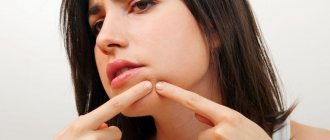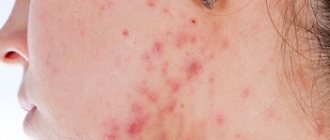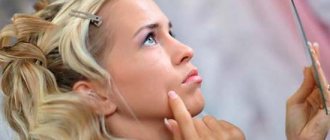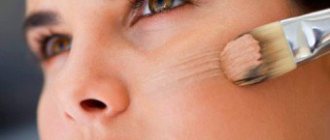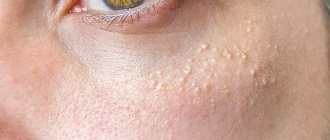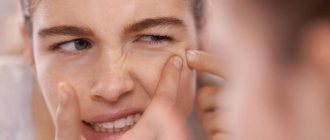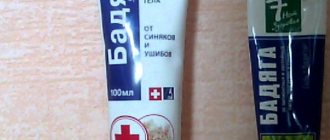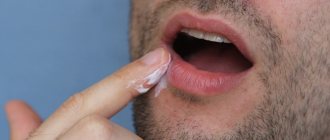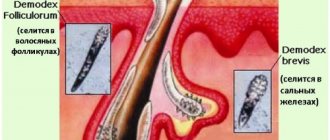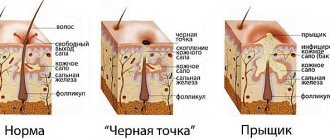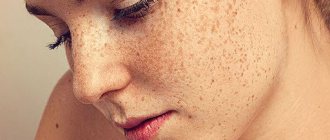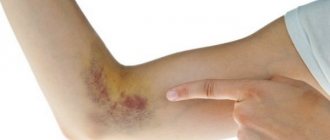- Subcutaneous pimple like a lump How to get rid of it on the face, cheek
- Difference between subcutaneous lumps and cyst
- Causes and symptoms of acne in the form of bumps on the face and body
- How to get rid of subcutaneous internal acne Best home remedies
In the next article, we will tell you about the causes and methods of getting rid of such specific acne on the face as subcutaneous acne, protruding in the form of bumps, formations. You will also learn about some home remedies that can help significantly reduce the size of subcutaneous bumps and get rid of them forever.
How does a subcutaneous pimple occur?
So, you discovered that a large subcutaneous pimple has appeared on your body, like a lump. How to get rid of it? In order to receive proper treatment, you need to have a good understanding of what exactly is happening in the body at the moment. Let's find out how these acne occur.
To protect the epidermis from the effects of microbes, as well as to soften the surface of the skin and the hairs growing on it, the human body produces sebum. It is secreted through special sebaceous glands, but sometimes clots form in their lumen, which disrupt this process and allow bacteria and microbes to multiply. This is how inflammation begins. Externally, this manifests itself in the form of red, painful bumps that slowly increase in size, causing a lot of discomfort. And often the time from the onset of pimple formation to its maturation is calculated in weeks.
Causes of acne
Slowly maturing, the described neoplasm grows, forcing you to painfully think: “Wow, what a subcutaneous pimple - like a lump! How to get rid of this nightmare? And most often, a person in such conditions decides to take radical measures - squeeze it out and that’s it! But this is precisely this – a very careless, moreover, frivolous decision. After all, the causes of acne can be very different:
- insufficient compliance with the rules of hygiene and skin care;
- hormonal imbalances;
- increased proliferation of pathogenic microflora living on the skin;
- insufficient or unbalanced nutrition;
- disturbances in the functioning of the gastrointestinal tract;
- allergic reaction, etc.
This means that the approach to treatment should be different in each specific case. In addition, even if you successfully squeeze out one pimple, you will not be healed: new ones will appear very soon, and if you also get an infection, the problem will develop into a serious inflammatory process, and ugly scars will remain on the skin, which, by the way, will be difficult to get rid of much more difficult. So what to do?
Kinds
The most common types of acne are as follows.
Hormonal
They appear due to hormonal imbalances in the body.
- More often such acne is found in women. This is explained by the surge of hormones before menstruation, when acne appears on the body and face.
- The skin of newborn babies is also often covered with small white formations, which go away on their own after a few days.
- Teenagers during puberty, women during pregnancy or menopause are susceptible to hormonal acne.
- Taking contraceptives and endocrine diseases can cause unhealthy skin appearance.
Watery
Formations with watery contents can occur in different parts of the body, including those hidden under clothing.
- The reason for their appearance is dry skin, which is irritated by friction against the fabric.
- Sometimes this is due to an allergic reaction to washing powder and other household chemicals or increased activity of the sebaceous glands.
When the first watery pimples are detected, it is necessary to find out and eliminate the causes of their appearance.
Otherwise, they increase in number and affect large areas of the body.
Inflamed
- They can be small or large (more than 0.5 cm), single or multiple, filled with pus or without a cavity.
- They cover the neck, back, shoulders and face.
- The disease is chronic, the sebaceous glands become inflamed and red pimples appear.
Often, after healing of large formations, scars remain.
Allergic
Photo: allergic rash
Small rashes occur immediately after contact with allergens.
In response to irritants, the body breaks out in hives. Such pimples are treated with antihistamines.
Colds
The reason for their formation is decreased immunity and vitamin deficiency.
- That’s why they appear more often in winter or spring, when the body especially lacks nutrients. The rash is painful, red and inflamed.
- A large pimple on the butt may appear after sitting in a cold place.
- It could also be a manifestation of a herpes infection, if there are pimples on the lip or mouth, or dermatitis.
- Formations in the superciliary space indicate problems with the gastrointestinal tract.
Photo: “cold” on the lips
In any case, it is necessary to consult a doctor who will accurately identify the cause and prescribe the correct treatment.
Dry
- Appear on dry and sensitive skin from an unbalanced diet or improper skin care.
- Small pimples located on the back and shoulders itch. Allergies are also the cause of their occurrence.
Fat
Appears on surfaces prone to oiliness.
They are located under the skin and do not have excretory ducts, so they cannot be squeezed out. Wen is removed by a dermatologist.
Yellow, green or blue
- The yellow color of the pimple contents indicates the presence of pus and a bacterial infection.
Photo: purulent rash
- Green indicates that the process is neglected, when the pus cannot come out for a long time.
Dark blue pimples are characteristic of demodicosis, a disease caused by a mite living in the sebaceous ducts.
If blue pimples are accompanied by flaking of the skin, inflammation and severe redness, then you should consult a dermatologist.
- Colored acne needs to be treated with special antibacterial gels or traditional methods (for example, compresses from aloe leaves).
- If you do not help the pus to come out, then in the future it is unlikely that you will be able to do without surgical opening of the canal.
A subcutaneous pimple appears like a lump - how to get rid of it?
Photos showing the skin defects we are considering can hardly be called pleasant. And if we add the discomfort a person experiences when touching a problem area (and sometimes there is no need to even touch - the inflamed area already hurts), then it will not be surprising that the sufferer wants to get rid of the nasty tubercle as soon as possible. However, it is highly not recommended to engage in amateur activities! As mentioned above, only a dermatologist can tell you the true cause of your acne after conducting the necessary examinations. He will also prescribe adequate therapy. And often treatment comes down not only to the fight against skin rashes, but also covers the underlying ailment. Therefore, prepare for the fact that the effect will not be quick, but by getting rid of the main problem, you will provide yourself with clean and healthy skin.
And, as a rule, the doctor not only prescribes medications, but also clearly outlines the rules that need to be followed in the future.
- Mandatory treatment of the affected area with antiseptics and provision of necessary body hygiene.
- Exclusion from the diet of fatty, spicy and smoked foods.
- Women are encouraged to avoid cosmetics that clog pores.
If you do not have the opportunity to contact a specialist, you can also resort to home remedies (at the same time adhering to the rules listed above).
What types of acne are there?
Blue pimples on the face and other parts of the body can appear for a variety of reasons. Let's look at the most popular of them.
Everything is clear from the name - they are formed as a result of hormonal imbalances in the body. They have certain features that should be taken into account when diagnosing.
- They usually appear in women before menstruation, during pregnancy or immediately after it, and also during menopause.
- In the first months after birth, newborns develop many white dots all over their face. These are also hormonal acne that go away on their own and do not require treatment.
- Teenagers also become familiar with acne during puberty. For them, it becomes a real problem, which is not at all easy to get rid of.
- Taking hormonal contraceptives or disruptions to the endocrine system can also have an unpleasant effect on the condition of the skin.
Their distinctive feature is that as soon as all the endocrine system disruptions end or are eliminated, all rashes go away on their own.
These pimples resemble small blisters. Most often they are infectious in nature and cause significant weight loss. A more detailed article was written about watery pimples here.
- The cause of watery rashes is mainly dry skin, which is irritated by constant friction against clothing.
- Sometimes such blisters on the body can appear as a result of an allergic reaction, for example, to powder, household chemicals or food.
When such watery rashes appear, it is imperative to find out and eliminate the cause of the disease. This is the only way to get rid of these rashes forever. If the cause is not established, then they will appear constantly, despite the therapy.
Inflammatory
Their distinctive feature is the presence of pus inside. They can appear on any part of the body - on the pubis, on the back, on the cheek. The size of such pimples varies greatly - from a few millimeters to several centimeters.
Most often, this disease is chronic. In addition to the presence of pus, there is always red, inflamed skin around them, and antibiotics are often used to combat them. They often leave scars behind.
Blue pimples on the body do not appear as a result of allergic reactions. Such rashes are the result of allergies to food, clothing, detergents and much more. A distinctive feature of this rash is its small size and severe itching.
For treatment, special antiallergic medications are used in the form of tablets, drops or injections.
The main reason for the appearance is reduced immunity and vitamin deficiency. That is why they most often appear in winter or spring, when the body is weakened and lacks nutrients. The rash is painful, red, may itch and be constantly inflamed.
For the same reasons, a blue pimple on the butt appears after sitting for a long time on a cold surface, for example, concrete steps or an iron bench.
In addition, the same rashes on the lips and around the mouth may be a sign of a herpes infection or the result of dermatitis. But in order to accurately determine the cause of their appearance, it is recommended to visit a doctor.
Such acne appears on dry and dehydrated skin due to poor nutrition or improper care of the epidermis.
They appear on any part of the body, they may itch, or they may not show themselves at all. You can get rid of them only after restoring the water balance of the skin.
These appear on skin prone to oiliness. As a preventive measure, careful facial care and the use of a neutral light cream are recommended. Squeezing pimples that appear on oily skin is prohibited. After all, the pus contained inside them can easily spread to healthy areas, which will lead to the spread of the rash to large areas of the body.
Yellow, green or blue
The color of a pimple is most often caused by the addition of purulent contents and infection.
For example, yellow ones appear as a result of suppuration and the addition of a bacterial infection.
Green appears as a result of the neglect of the purulent process, when the contents of the abscess cannot come out for a long time.
And dark blue pimples are the result of demodicosis, which is caused by a mite living in the sebaceous ducts. Here, self-medication can only do harm, since getting rid of a tick requires special medications, which can only be prescribed by a dermatologist.
How to remove a blue pimple? Often this can only be done with the help of antibacterial drugs alternating with folk remedies, for example, applying aloe pulp.
If these procedures do not help get rid of the pus, then in the future you will have to use surgery to remove the purulent contents.
How to treat acne at home
If a dense subcutaneous pimple (like a bump) pops up, many publications on this topic will tell you how to get rid of it at home. The main thing is to be careful and not overdo it.
Since large pimples ripen very slowly, to speed up the process and draw out the pus, doctors advise using ichthyol ointment, Vishnevsky ointment or Levomekol. The affected area is lubricated with one of the listed products, and a piece of cotton wool or bandage is covered on top and sealed with a bandage. This compress is best done at night.
An ordinary aloe leaf can also be very effective. It is applied to the pimple with the cut part and fixed with a band-aid.
Salt lotions are quite effective. For them, dilute 2 tbsp in a glass of boiling water. l. salt and, after cooling slightly, apply with a cotton swab to the inflamed area. By the way, this procedure should be done several times a day.
It is also recommended to wipe acne with alcohol tincture of propolis. But you shouldn’t apply a cotton swab with it to the formations for a long time - you can get a burn on an already inflamed area of skin.
What to do if acne appears on the back
In some cases, the occurrence of rashes is especially problematic, for example, if you have a painful subcutaneous pimple like a lump on your back. How to get rid of it?
It is quite difficult to apply special ointments or lotions to the skin on your back (of course, if you do not have a reliable assistant at home). In such cases, it is usually recommended to take baths with chamomile infusion and sea salt, and brewer's yeast is prescribed internally. They are produced in both dry and liquid form. Liquid ones are considered more effective. In order to get rid of furunculosis, they are taken for a month 3 times a day 15 minutes before meals. And although this product has no contraindications, it will still be better if you consult a doctor first.
By the way, to combat rashes on the face, as well as for oily and porous skin, masks made from brewer's yeast are used - they help regulate the production of sebum and disinfect the surface of the skin. This way, you don't have to worry about getting a subcutaneous pimple (like a bump).
Blue, green and yellow pimples
All these are purulent acne. They are named by color depending on how it looks. When the head is filled with light pus, the pimple has a yellowish-white color, but if the skin around the pimple is edematous and swollen, then a bluish color appears. The internal purulent contents may also acquire a greenish tint when they cannot break through for a long time.
Dark acne, or rather “colored” acne, requires treatment. If they are started, surgical intervention will be required; opening the canal is impossible. Therefore, you need to help the contents come out. For these purposes, you can use a special acne gel. Also an excellent remedy is aloe. You need to take a leaf, remove the outer skin and prepare a gauze pad, slightly larger in size than the inflamed area. Place the sheet on gauze and apply the cut side to the sore spot, fixing it overnight. In the morning, as a rule, the abscess will rupture.
Iodine provides good assistance in the fight against such acne. As soon as the development of a pimple with purulent contents begins, you need to lubricate the area that has already changed color to bluish with iodine. So that later there will be no yellow-green abscesses on the face.
How to get rid of rashes on the cheek and the whole body?
When treating subcutaneous acne, you should remember that the treatment must be comprehensive. That is, using only baths with medicinal herbs or ointments, you will not achieve the desired result. Procedures must be combined and combined so that the effect is maximum.
For example, what should you do if a subcutaneous pimple pops up on your back like a bump? How to get rid of it? The problem is aggravated by the fact that the skin here is rougher than on the face, in addition, the areas of inflammation are constantly irritated due to contact with clothing. There is only one way out - try to act in several directions at once: baths, lotions, compresses, observing hygiene rules, using ointments.
How to prevent the problem
Only a specialist, in particular a dermatologist, can voice a complete list of measures to effectively combat subcutaneous acne and prevent them. Medical recommendations, drawn up taking into account the individual lifestyle and health status of the patient suffering from acne and bumps, will help achieve optimal results. General advice for those whose skin is prone to bumpy acne:
- make a choice in favor of cosmetics based on herbal ingredients;
- change your diet (include more vegetables in the menu, stop eating fried and spicy foods, smoked and sweet foods);
- increase time spent in the fresh air;
- undergo a course of ozone therapy (elimination of pathogenic microflora through injections).
The beauty and health of the skin, the absence of formations in the form of bumps, directly depends on the quality of self-care. Giving up coffee and cigarettes, regularly observing hygiene rules, paying attention to your own health (examinations by an endocrinologist and dermatologist) is a minimum set of measures that will allow you to forget about pimples and bumps and delight yourself and those around you with the natural beauty of skin that glows from the inside.
How to achieve good results from acne treatment
So, let's repeat once again what to do if you have a subcutaneous pimple like a lump. How to get rid of new rashes?
- Wear things made from natural fabrics, avoid clothes that are tough and irritating to the skin, thick seams and tight straps.
- Take the baths described above, and always start with your hair to avoid clogging your pores with the substances in your shampoo and conditioner.
- Don't use a washcloth that's too hard, but you don't want one that's very soft either.
- Do not get carried away with solarium and sunbathing, avoid massage oils.
- Take brewer's yeast and eat more fiber-rich foods.
- And, of course, wipe problem areas with salicylic alcohol and apply anti-inflammatory ointments to them.
With enough patience and persistence, you will achieve good results.
